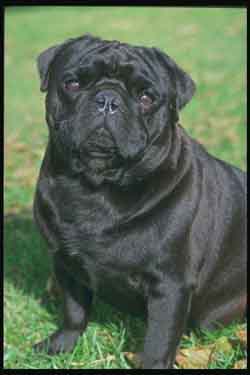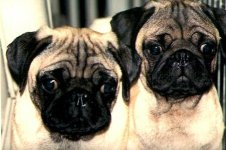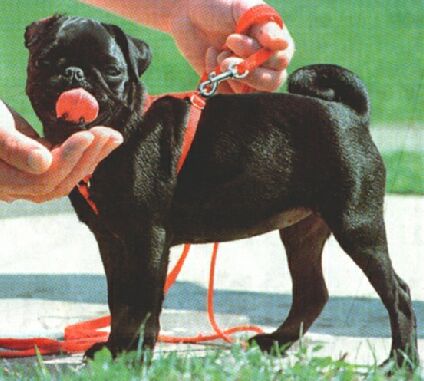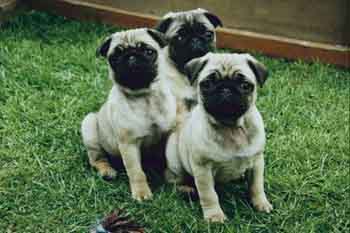|
|
|


AT A GLANCE
The Pug is an even-tempered breed who is playful, outgoing, dignified, and attracts with his great charm. Very affectionate and desirous of human contact.
A delightful blend of dignity and comedy, the Pug is an amiable and confident companion, that can be stubborn and headstrong at times, but is pleasant and always willing to please. Pugs love to show off.
Height: 10 - 11 inches at the withers ( 25 - 28 cm )
Weight: 14 -18 pounds ( 6 - 8 kg )
Colors: The only colors acceptable are black, silver or apricot-fawn with black muzzle or mask, ears, cheek moles and trace down back.
Coat type: Fine, smooth and short.
Maintenance: Pugs need minimal coat care but regular cleaning of facial wrinkles.
Living Conditions: Content even in tiniest apartment but regular walks are essential.

HISTORY
Pug was first thought to have originated in Holland. More recent theory claims that the Pug is an Oriental breed and is probably the smooth-coated, long-legged version of the Pekingese. It originated in Tibet as early as 400 B. C. First popular in Japan & China, the breed was introduced in Europe around 1572.
The Pugs that were traded to Europe seem to have first landed in Holland. The Dutch named the breed Mopshond, which is still in use today. Pugs
were known to be within the household of William III and Mary II when they
ascended to the throne of Great Britain in 1688. The Pugs popularity spread throughout Europe, with the breed referred to in
France as the Carlin, in Spain as the Dogullo, at the same time, they were Mops
in Germany and the Caganlino in Italy. In France, the breed was popularized by
Josephine Bonaparte, owner of the Pug named Fortune.
CHARACTERISTICS
Adventurous and adaptable, Pug is an easy-going little dog whose flexibility and telents make him suitable for any dog owner. Pugs, counted among the most functional of the toy size breeds, are easily trained and happy to be helpful. They like children and other dogs. The Pug’s tidy package of charm, dignity and serenity makes him attractive to a variety of owners with good taste.
FAQ
 Which is better for just a pet - a male or a female Pug?
Which is better for just a pet - a male or a female Pug?
In general, males are more laid back, loving and people oriented than females tend to be. Females, on the other hand, make better alert dogs (they watch for strange things going on at "their" house) and are more aloof and independent. If you're looking for a couch-potato type dog, then a male would be better suited. If you're wanting a dog who's pretty independent and not as demanding, then a female is probably better. These are generalities, of course. There are some males who are independent and some females who are more people oriented - but for the most part the characterizations hold true.
Do Pugs make good watch dogs or guard dogs?
Not usually. Some pugs may alert you that someone is nearby by barking gently (Pugs don't bark loudly, in general, because it's muffled by the lips), but most Pugs are more interested in greeting new people rather than scaring them off. The look of the Pug often will scare people - especially if you have a Bullmastiff in the yard too. Then you can just say that the Pug is a puppy and it grows up into the Bullmastiff (sorry, that's Pug humor).
How much daily care do they require?
Really not that much. On a weekly basis, you should brush their coat, keep their faces clean and check their eyes for problems. Must Pugs take about 20 minutes a week per dog. Monthly, you should also trim their toe nails, and maybe give them a bath if they need it.
I don't want a dog in the house. Why can't Pugs stay out of doors?
Pugs cannot tolerate high heat and humidity for very long. Dogs cool off by panting and their long tongues and noses give them more cooling area. Pugs have virtually no cooling area for their bodies, so they can (and will) literally over heat and die in less than 30 minutes outdoors in high heat and/or humidity.
 Do Pugs really snore that much, or that loudly
Do Pugs really snore that much, or that loudly
In a word, yes. Almost every Pug snores, and usually it's not as loud as
a person, but it can easily be mistaken for someone snoring. Pugs snort, snarfle
and snore and often will pass a lot of gas too. Just expect them to be noisy
dogs, but not barkers.
To learn more about Pug care, please visit http://www.puppypower.com/caretips.htm.
The following information has been compiled after research and reference
to various sources with some additions made by myself based on experience.

